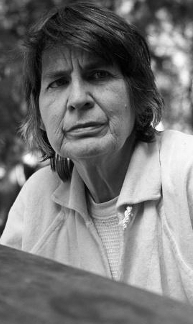Ruth Mountaingrove facts for kids
Quick facts for kids
Ruth Mountaingrove
|
|
|---|---|

Self portrait of Ruth Mountaingrove
|
|
| Born |
Ruth Shook
February 21, 1923 |
| Died | December 18, 2016 (aged 93) Eureka, California, U.S.
|
| Education |
|
| Known for | WomanSpirit; The Blatant Image; Turned On Woman Songbook; For Those Who Cannot Sleep |
| Spouse(s) |
|
Ruth Mountaingrove (born February 21, 1923 – died December 18, 2016) was an American photographer, poet, and musician. She was known for her photos that showed the lives of women living in special communities in Southern Oregon. Ruth was a strong supporter of women's rights and equality.
Contents
Early Life and Education
Ruth Shook was born in Philadelphia, Pennsylvania, on February 21, 1923. Her parents were Edith Shelling and Herbert Daniel Shook.
In 1945, she earned a college degree from Kutztown State Teacher's College. She studied science and also learned English and Spanish. In 1946, she published a book of poems called Rhythms of Spring. She then married Bern Ikeler. After 19 years and having five children, they divorced in 1965.
Ruth joined a group called the National Organization for Women (NOW) in 1966. She helped start other groups that supported women in difficult situations. She also helped create some of the first support groups for women in her city.
WomanSpirit Magazine
In 1970, Ruth met Jean, who would become her partner. Ruth started writing for magazines and newspapers in Oregon. She and Jean faced challenges and decided to move. They were looking for a new place to live on the West Coast.
In 1971, they moved to Southern Oregon. They lived in a community called Mountain Grove for two years. Later, they moved to Golden, Oregon, which was a community for women. There, they started a magazine called WomanSpirit.
WomanSpirit was published every three months from 1974 to 1984. It was the first American magazine for women that focused on both women's rights and spirituality. Ruth and Jean wanted the magazine to be "international and radical feminist." This meant they wanted to change how society worked and what people valued. They hoped the magazine would help women feel good about themselves and know they were not alone. The magazine shared stories and ideas from its readers.
Oregon Women's Land Trust
Ruth Mountaingrove and another artist named Tee Corinne taught photography workshops. They called them "ovular" workshops instead of "seminars." This was a way to use words that focused on women. In these workshops, women learned photography and explored how they saw themselves, which was different from how men often pictured women. A magazine called The Blatant Image, which focused on feminist photography, grew from these workshops.
Ruth also took photos for a magazine called Lesbian Love and Liberation in 1973.
In 1978, Ruth and Jean bought land called Rootworks. There, Ruth published a songbook called Turned on Woman's Songbook. She also published a book of poems titled For Those Who Cannot Sleep.
From 1974 to 1986, Ruth spent 12 years taking pictures of women in women's communities across Oregon and other parts of the United States. She photographed meetings of the Oregon Women's Land Trust. This group helped women get access to land in the countryside. This allowed them to live in communities that were separate from mainstream society.
Ruth and Jean separated in 1985.
Her Works as an Artist
"For Those Who Cannot Sleep"
Ruth wrote a series of poems called “For Those Who Cannot Sleep.” She wrote these poems in the late 1950s when she was in her late twenties. At that time, she was a housewife and a mother of three young children. The poems show her deep thoughts and feelings during a challenging time. For example, she wrote about a world where "The H bomb hovers/Yet/Birds build/Trees feather into leaf." She also asked, "If we cannot save ourselves/Who can save us?/(...)/Where is the sun?"
“Who Killed the Women?”
In 1966, Ruth wrote a song called “Who Killed the Women?” This song was used at rallies and meetings in Philadelphia to support women's causes.
"Turned on Women"
This was a new kind of songbook made by women. Ruth created the original idea for it. Other women helped organize the songs, and some were hired to write them down as musical notes. Ruth wrote about how these songs were created and what inspired them. One of her main goals for the book was "to encourage women to make their own music, sing their own songs." Ruth preferred to call herself a "women's folk song writer" rather than a composer. She took small, everyday events and turned them into songs. For example, one song called "Haircut" was about her friend's new haircut.
Later Work
After moving to Arcata, California, in 1986, Ruth's art changed. She moved from taking documentary photos to creating more experimental images. She used darkroom techniques and digital tools. She called this process "drawing with light." She explored photography as a way to create abstract art, like ink drawings or paintings.
Her photographs were shown in art exhibits in California, Massachusetts, Oregon, Pennsylvania, Texas, and Washington. She also had solo shows at three places: Northcoast Internet, SHNEngineering, and The Lesbian, Gay, Bi-sexual, Transgendered Center.
Death
Ruth Mountaingrove passed away on December 18, 2016, at the age of 93. She died at Ida Emmerson Hospice House in Eureka.
See also
- Feminist art
- Goddess movement
- Lesbian feminism


